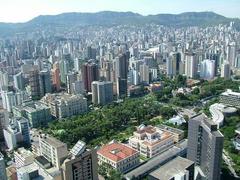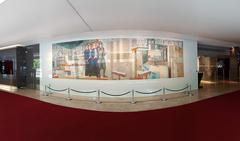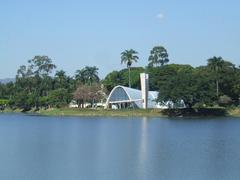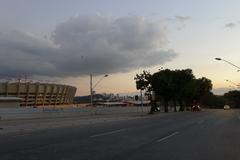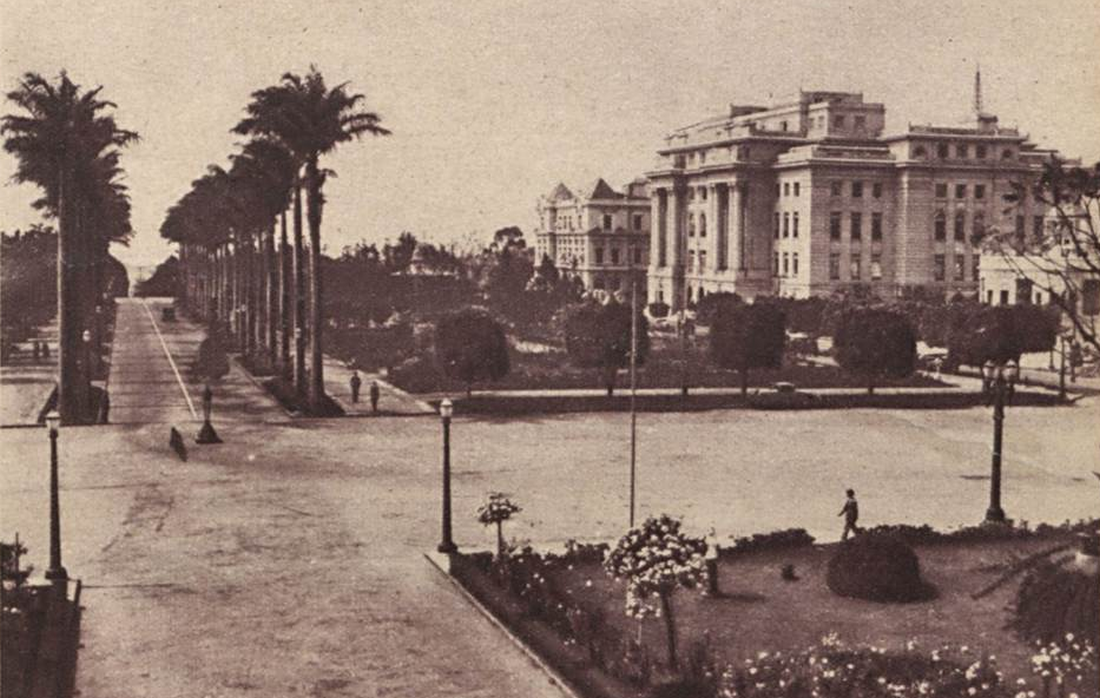
Comprehensive Guide to Visiting Alameda Travessia, Belo Horizonte, Brazil
Date: 16/07/2024
Introduction
Alameda Travessia, situated in the vibrant city of Belo Horizonte, Brazil, is a remarkable blend of historical significance, architectural marvels, and cultural richness. Established during the early 20th century, this central thoroughfare was an integral part of the urban planning that characterized the modernization of Belo Horizonte, which was designed to replace Ouro Preto as the capital of Minas Gerais in 1897 (Instituto do Patrimônio Histórico e Artístico Nacional). The architectural landscape of Alameda Travessia features an eclectic mix of neoclassical, art deco, and modernist styles, reflecting the evolution of the city’s architectural trends. Key landmarks, such as the Palácio da Liberdade and the Museu de Arte da Pampulha, showcase the grandeur and cultural commitment of the city’s early planners and modern architects like Oscar Niemeyer (Palácio da Liberdade, Museu de Arte da Pampulha).
Beyond its architectural heritage, Alameda Travessia is a cultural hub, home to significant museums, art galleries, and historical sites. It has been the backdrop for pivotal events in Brazil’s political history, including rallies that played crucial roles in the nation’s transition to democracy in the mid-20th century. The area is not only a testament to the city’s past but also a vibrant, dynamic part of its present, attracting tourists and locals alike with its blend of historical charm and modern amenities. This guide aims to provide comprehensive visitor information, highlighting key attractions, practical tips, and cultural insights to make your visit to Alameda Travessia unforgettable.
Table of Contents
- Introduction
- Origins and Development
- Architectural Heritage
- Cultural Significance
- Historical Events
- Preservation Efforts
- Modern-Day Relevance
- Visitor Information
- Nearby Attractions
- Accessibility
- Key Figures
- Economic Impact
- Future Prospects
- FAQ
- Conclusion
- Sources
Origins and Development
Alameda Travessia was developed during the early 20th century, coinciding with the establishment of Belo Horizonte as the new capital of the state of Minas Gerais in 1897. The city was meticulously planned to replace Ouro Preto, the former capital, and was designed to embody modernity and progress. Alameda Travessia, as part of this urban planning, was intended to be a central thoroughfare that would facilitate movement and commerce within the city.
Architectural Heritage
The architectural landscape of Alameda Travessia reflects the eclectic styles that were popular during its development. The area features a mix of neoclassical, art deco, and modernist buildings, which collectively narrate the evolution of architectural trends in Belo Horizonte. Notable structures include the Palácio da Liberdade, an iconic neoclassical building that served as the official residence of the governors of Minas Gerais. The palace, completed in 1897, is a testament to the grandeur and ambition of the city’s early planners.
Cultural Significance
Alameda Travessia has long been a hub for cultural activities in Belo Horizonte. The area is home to several important cultural institutions, including the Museu de Arte da Pampulha, which houses a significant collection of modern and contemporary art. The museum, designed by the renowned architect Oscar Niemeyer, is a key example of modernist architecture and reflects the city’s commitment to cultural development.
Historical Events
Throughout its history, Alameda Travessia has been the site of numerous significant events. During the 1930s and 1940s, the area was a focal point for political rallies and public demonstrations. One notable event was the 1945 rally in support of the end of the Estado Novo, a dictatorial regime led by Getúlio Vargas. The rally, which drew thousands of participants, was a pivotal moment in Brazil’s transition to democracy.
Preservation Efforts
In recent years, there have been concerted efforts to preserve the historical and cultural heritage of Alameda Travessia. The area has been designated as a cultural heritage site by the Instituto do Patrimônio Histórico e Artístico Nacional (IPHAN), which is responsible for the preservation of Brazil’s historical and cultural assets. Preservation initiatives have included the restoration of historic buildings and the promotion of cultural events that celebrate the area’s rich history.
Modern-Day Relevance
Today, Alameda Travessia continues to be a vibrant and dynamic part of Belo Horizonte. The area is a popular destination for both locals and tourists, offering a blend of historical charm and modern amenities. Visitors can explore the historic architecture, visit cultural institutions, and enjoy the numerous cafes, restaurants, and shops that line the street. The ongoing preservation efforts ensure that Alameda Travessia remains a living testament to the city’s history and cultural heritage.
Visitor Information
- Visiting Hours: Alameda Travessia is accessible 24/7, though individual attractions like the Palácio da Liberdade and Museu de Arte da Pampulha have specific visiting hours.
- Tickets: Entry to Alameda Travessia is free, but some cultural institutions may charge an entrance fee. Check their official websites for up-to-date information.
- Travel Tips: Wear comfortable walking shoes, as you’ll likely be exploring on foot. Consider visiting early in the morning or late afternoon to avoid the heat.
Nearby Attractions
- Praça da Liberdade: A beautiful square featuring gardens, fountains, and cultural institutions.
- Mercado Central: A bustling market where you can experience local food, crafts, and culture.
- Centro Cultural Banco do Brasil (CCBB): A cultural center hosting exhibitions, theater performances, and workshops. Centro Cultural Banco do Brasil.
- Museu das Minas e do Metal: A museum dedicated to the mining history of Minas Gerais. Museu das Minas e do Metal.
- Parque Municipal Américo Renné Giannetti: A green oasis in the heart of the city, perfect for a peaceful retreat. Parque Municipal Américo Renné Giannetti.
- Museu de Arte da Pampulha: Part of the Pampulha Modern Ensemble, a UNESCO World Heritage site. Museu de Arte da Pampulha.
- Igreja São Francisco de Assis: An architectural masterpiece by Oscar Niemeyer. Igreja São Francisco de Assis.
- Inhotim: One of the largest open-air contemporary art museums in the world. Inhotim.
- Savassi: A vibrant neighborhood known for its lively atmosphere and nightlife.
- Pampulha Ecological Park: A large green space offering a variety of outdoor activities. Pampulha Ecological Park.
Accessibility
Alameda Travessia is wheelchair accessible, with ramps and pathways designed to accommodate all visitors. Public transportation options, including buses and taxis, are readily available.
Key Figures
Several key figures have played a role in the development and preservation of Alameda Travessia. Aarão Reis, the chief urban planner of Belo Horizonte, was instrumental in the initial design and development of the area. His vision for a modern, well-planned city laid the foundation for the growth and prosperity of Alameda Travessia. In more recent times, preservationists and cultural advocates, such as the members of the Associação dos Amigos do Patrimônio Histórico de Belo Horizonte, have worked tirelessly to protect and promote the area’s historical significance.
Economic Impact
The historical and cultural significance of Alameda Travessia has also had a positive economic impact on Belo Horizonte. The area attracts a significant number of tourists each year, contributing to the local economy. The preservation of historic buildings and the promotion of cultural events have also created job opportunities and stimulated economic growth.
Future Prospects
Looking ahead, the future of Alameda Travessia appears bright. Ongoing preservation efforts, coupled with a growing interest in cultural tourism, suggest that the area will continue to thrive. Plans for further restoration projects and the development of new cultural initiatives are in the works, ensuring that Alameda Travessia remains a vital and dynamic part of Belo Horizonte for years to come.
FAQ
- What are the visiting hours for Alameda Travessia? Alameda Travessia is open 24/7, though specific attractions may have their own hours.
- How do I get tickets for Alameda Travessia? Entry to the area is free, but some cultural institutions may require tickets. Check their official websites for details.
Conclusion
In summary, the historical significance of Alameda Travessia is multifaceted, encompassing its origins, architectural heritage, cultural importance, and economic impact. The area’s rich history and ongoing preservation efforts make it a must-visit destination for anyone interested in the cultural and historical heritage of Belo Horizonte.
References
- Instituto do Patrimônio Histórico e Artístico Nacional (IPHAN). Retrieved from https://www.gov.br/iphan/pt-br
- Palácio da Liberdade. Retrieved from https://www.palaciodaliberdade.mg.gov.br/
- Museu de Arte da Pampulha. Retrieved from https://www.mapbh.com.br/
- Associação dos Amigos do Patrimônio Histórico de Belo Horizonte. Retrieved from https://www.amigosdopatrimonio.org.br/

